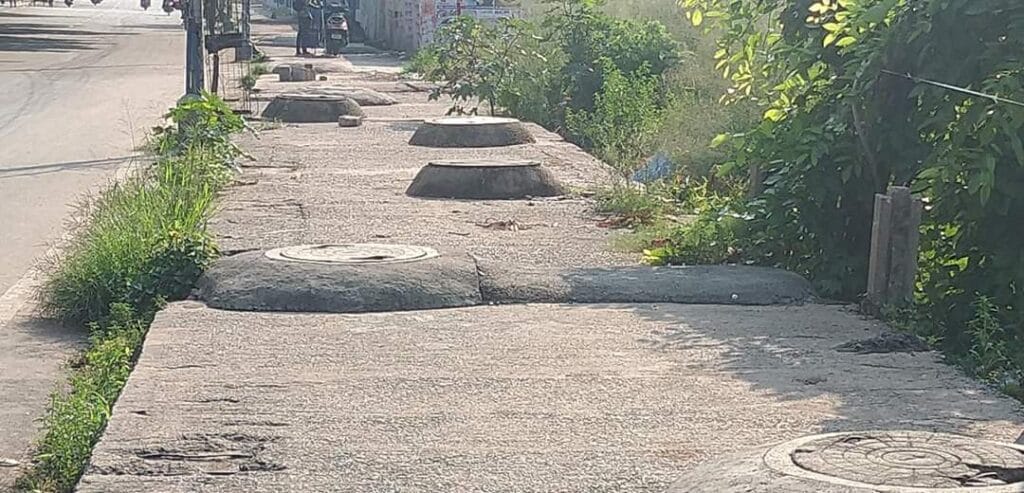Every time motorists or pedestrians pass by Sembudoss street and Armenian street in George Town, they feel like they are part of a hurdle race that never seems to end. Apart from the fact that many of the roads in the locality are riddled with potholes, manhole covers which are protruding out on the road add to the misery of citizens. These unscientifically built structures that are quite a few inches above ground, pose a threat to commuters.
Apart from George Town, these utility hole chambers that are used for covering the underground drainage pipes, can be seen in several other places in Chennai including Chinnayan New Colony 2nd Main Road, Nelvayal Road, Perambur High Road and Patel Road in Ward 71 (Zone 6).
Read more: Why road milling work calls for active involvement of Chennai citizens
Constant danger for commuters and pedestrians
Here is an example of the dangers they pose to life and limb: I was travelling on a two-wheeler with Goverdhan, a resident of Perambur and Co-Convener of the Perambur Neighbourhood Development Forum (PNDF), when we were caught unawares by a manhole chamber cover that was jutting out way above the ground. It was night time and visibility was low and since we were on a two-wheeler, we did not see the huge structure jutting out almost in the middle of the street. We had a bad experience as this particular manhole cover is located on a blind curve and as we were taking a turn, we hit the cover and the vehicle skidded, throwing us on to the street. Both of us not only suffered minor injuries but the two-wheeler was also damaged.
There are more than one lakh utility chambers in the city and many of them have not been placed correctly. Some of these utility covers which are not fixed properly occupy a lot of space on the street, making it difficult for motorists to manoeuvre their vehicles. Not only are they a safety hazard but, they also contribute to wear-and-tear of vehicles. Accidents occur when the roads are inundated during the monsoon season and the jutting manhole doors are submerged, as the commuters are unaware of these high-rise covers.

Pedestrians are forced to hop, skip and jump while walking on the footpaths in Perambur High Road North Side along the railway tracks, Nelvayal Road and other locations across our city as storm water drains along footpaths also have raised manhole covers.
There are strict rules to be followed while laying and re-laying roads to ensure that the manholes are at the same level as the road surface. But these are often not followed when the Greater Chennai Corporation (GCC) takes up roadworks.
Need for scientific approach for placing manhole covers
Many residents and even members of the Alliance of Residents Welfare Associations (AoRWA) have made several representations to both the GCC and the Chennai Metropolitan Water Supply and Sewerage Board (CMWSSB) to curb this menace. These issues have been escalated by me through the PNDF, on behalf of the residents of Perambur, to ensure that the manhole chambers are constructed in a way that the chamber covers are aligned with the road. We get to see several manhole chamber doors fixed in this manner across the city.
During our interactions with officials and contract workers, they claimed that the chamber covers will get automatically aligned when the road is resurfaced the next time. The irony is — some of these roads were resurfaced only a couple of weeks or months ago, therefore are we supposed to wait for a few more years before the issue is addressed?

Read more: Better road design, not penalties the key to improving safety on Chennai roads
Here is what we got to see in Rajabhathar Street, Ward 71, Zone 6, Perambur — this road was milled and left unattended for over a period of six months. Before resurfacing the road the local authorities decided to replace the water mains and electricity cables, however the long pending demand from the residents to replace the existing sewer mains was blatantly ignored despite several representations. Residents who continued to live in unsanitary conditions with sewage overflowing on the streets sought our help.
Members of PNDF intervened and requested CMWSSB officials to replace the sewer lines before resurfacing the road. Instead of addressing the core issue, they chose to increase the height of two manhole doors by over 6 inches to stop the sewage from flowing on the street. We knew it was only a temporary cosmetic makeover that was being delivered and continued to bark against the wall.
When the road was resurfaced they increased the level of the road by applying a layer of Wet Mix Macadam. This social media post which was tagged to Greater Chennai Corporation is self explanatory. What was the purpose of milling if the GCC had already decided to increase the height of the manhole doors as well as the road? Lack of proper planning and coordination between the various agencies of the local administration has resulted in a loss to the exchequer.
There needs to be a zero tolerance approach when it comes to the safety of commuters or pedestrians. Nowadays, we have advanced technology and hi-tech machines that are being used to fix the manhole doors properly across the world and even in other states across India. A consistent effort needs to be made by the Chennai civic authorities to assess the problem and use technology to fix the manhole covers neatly aligned to the carriageway.